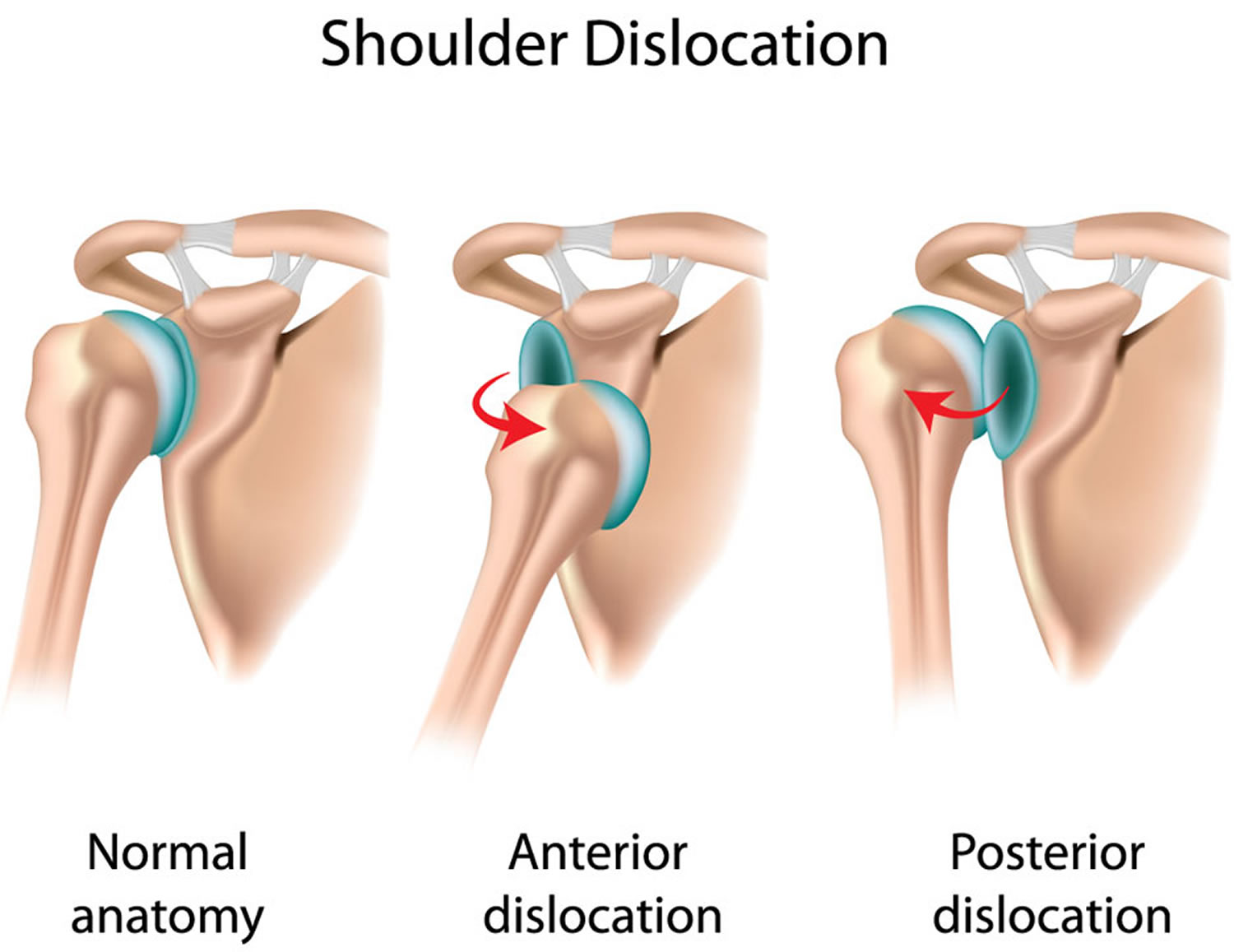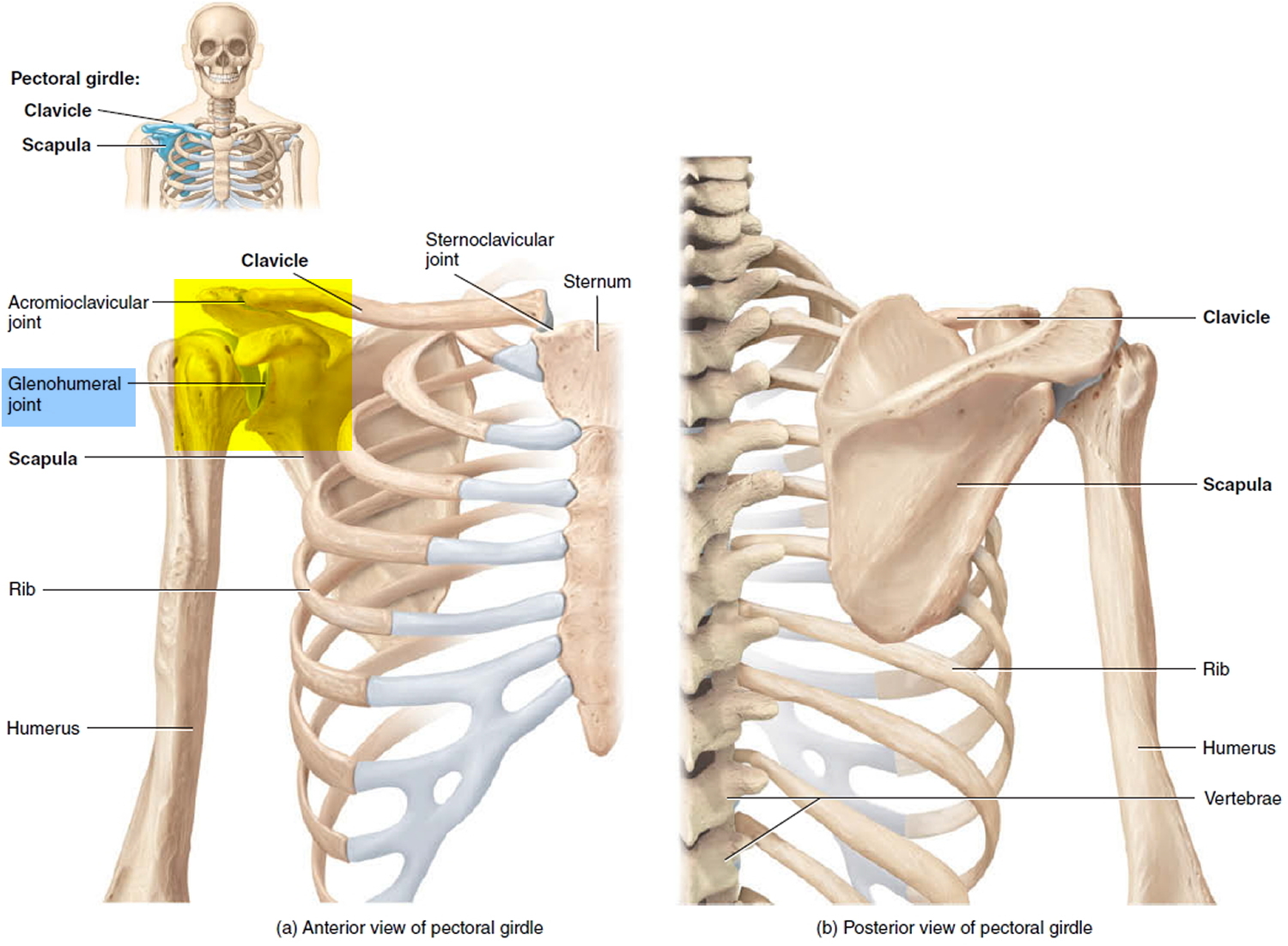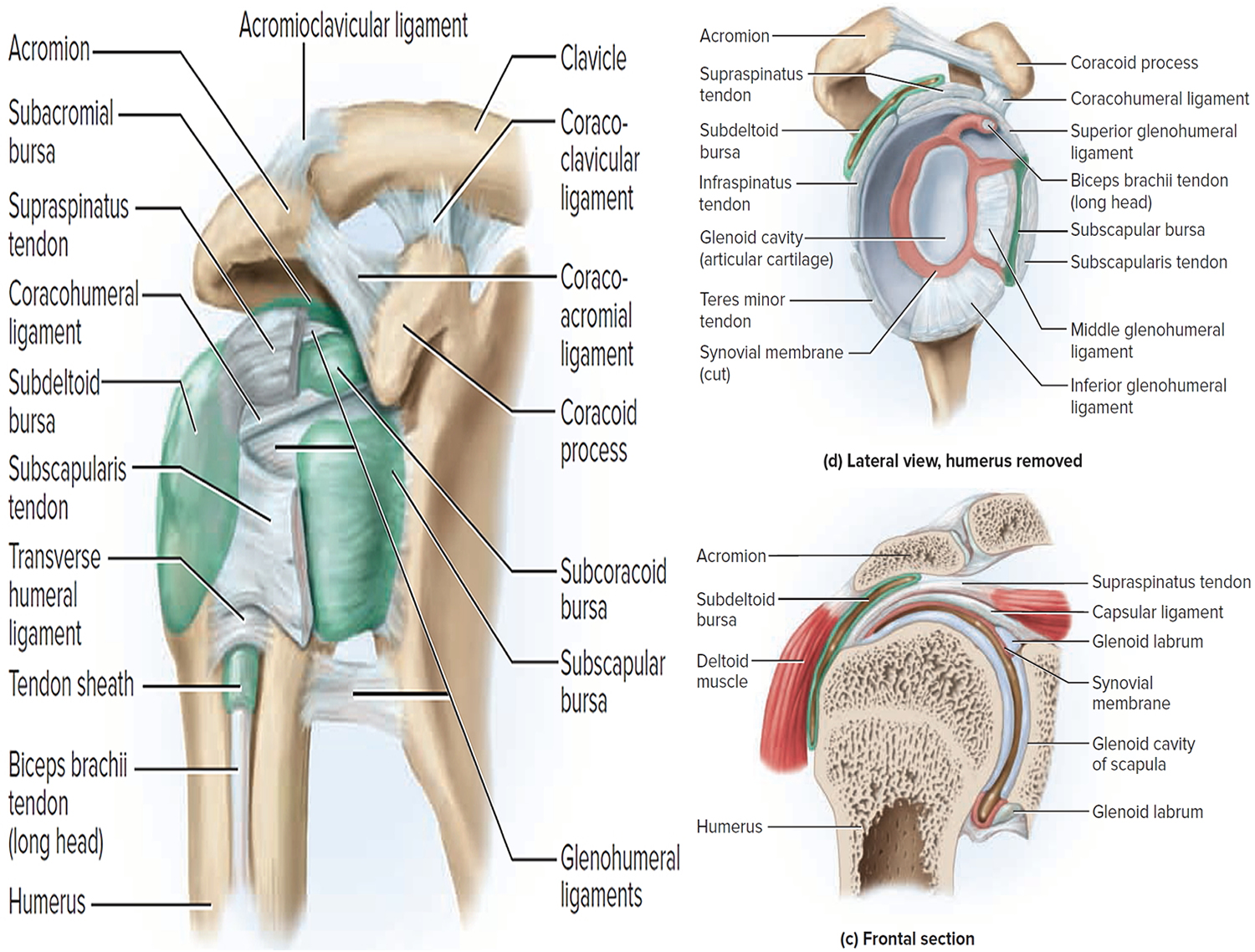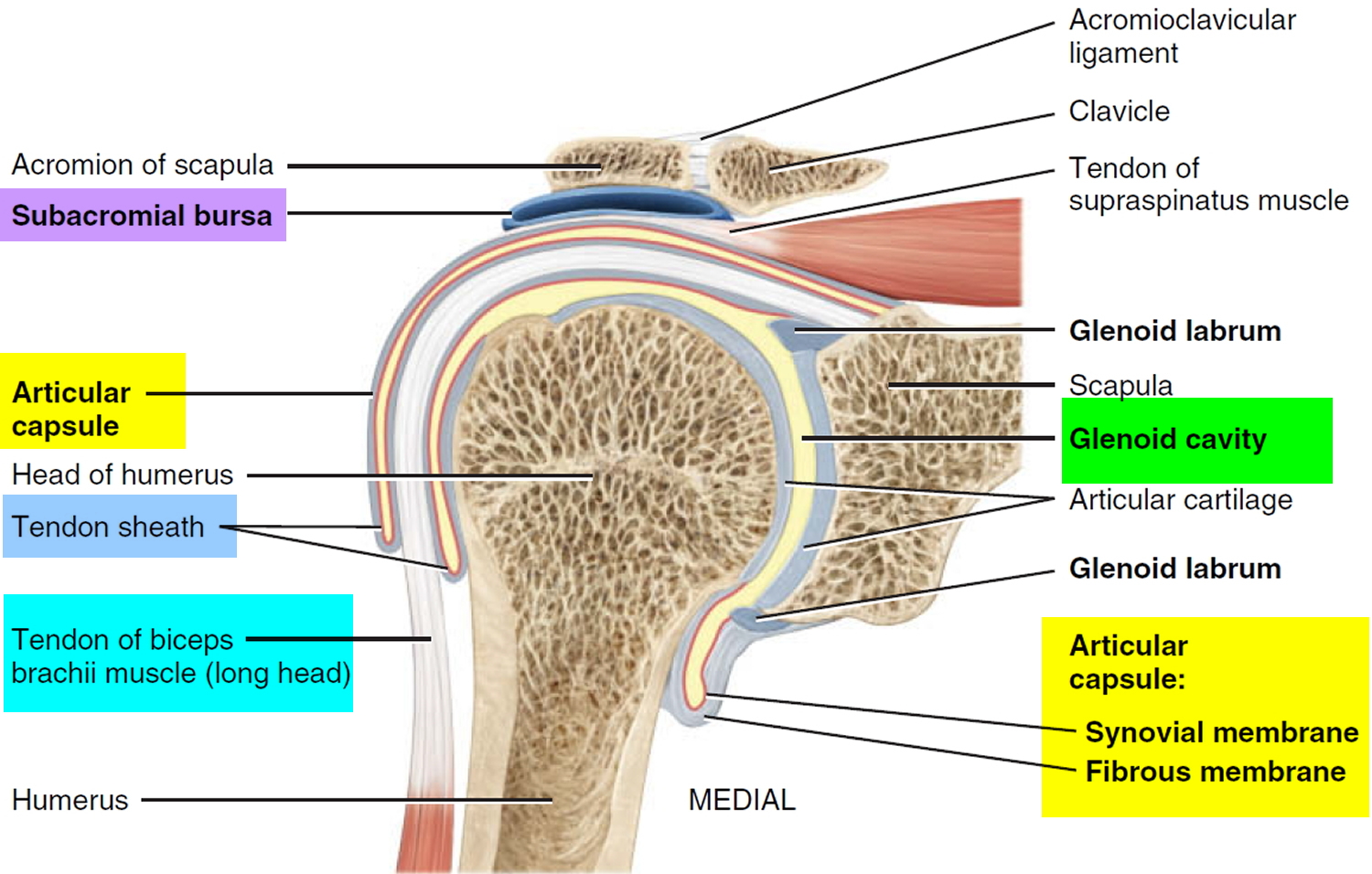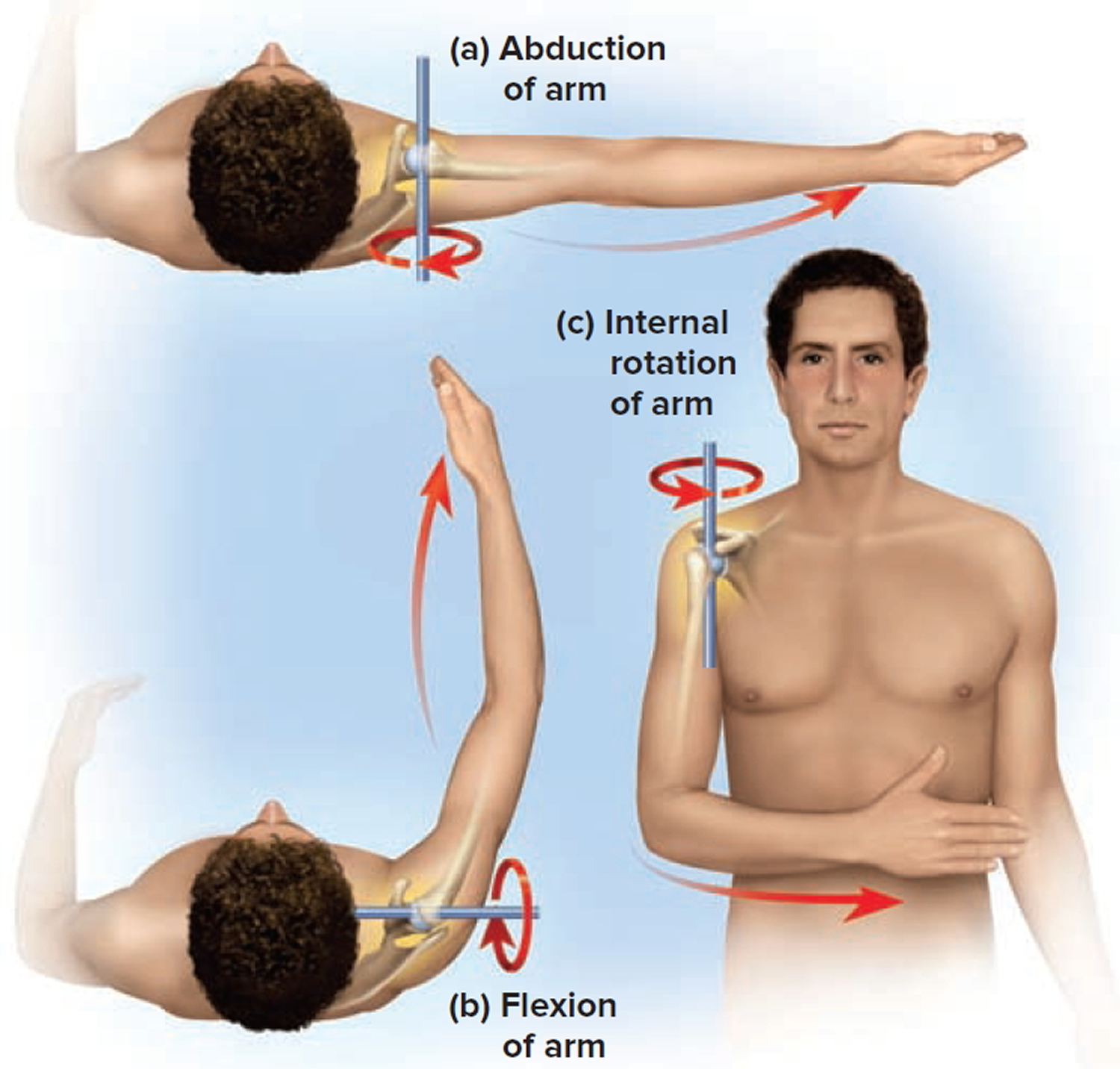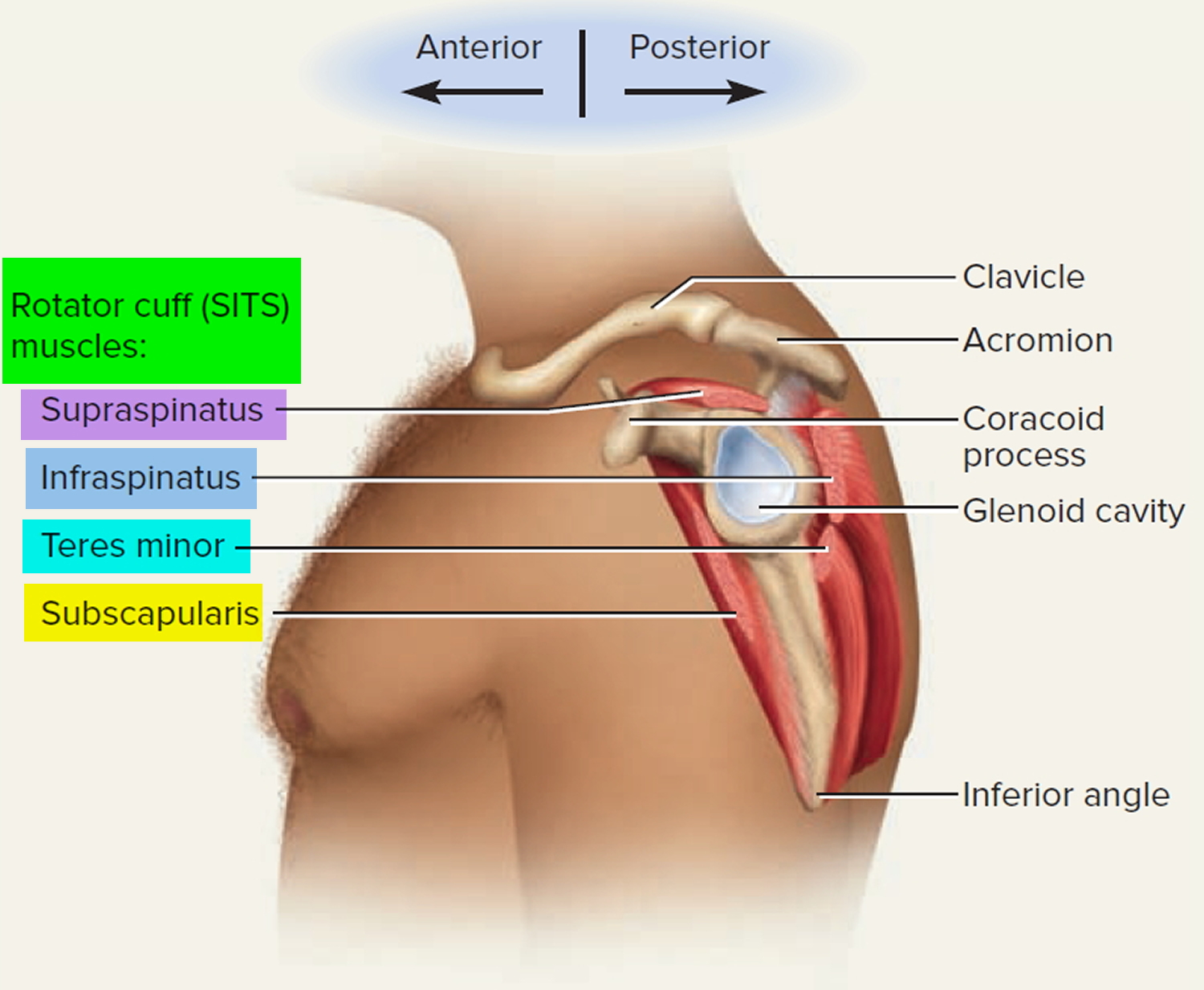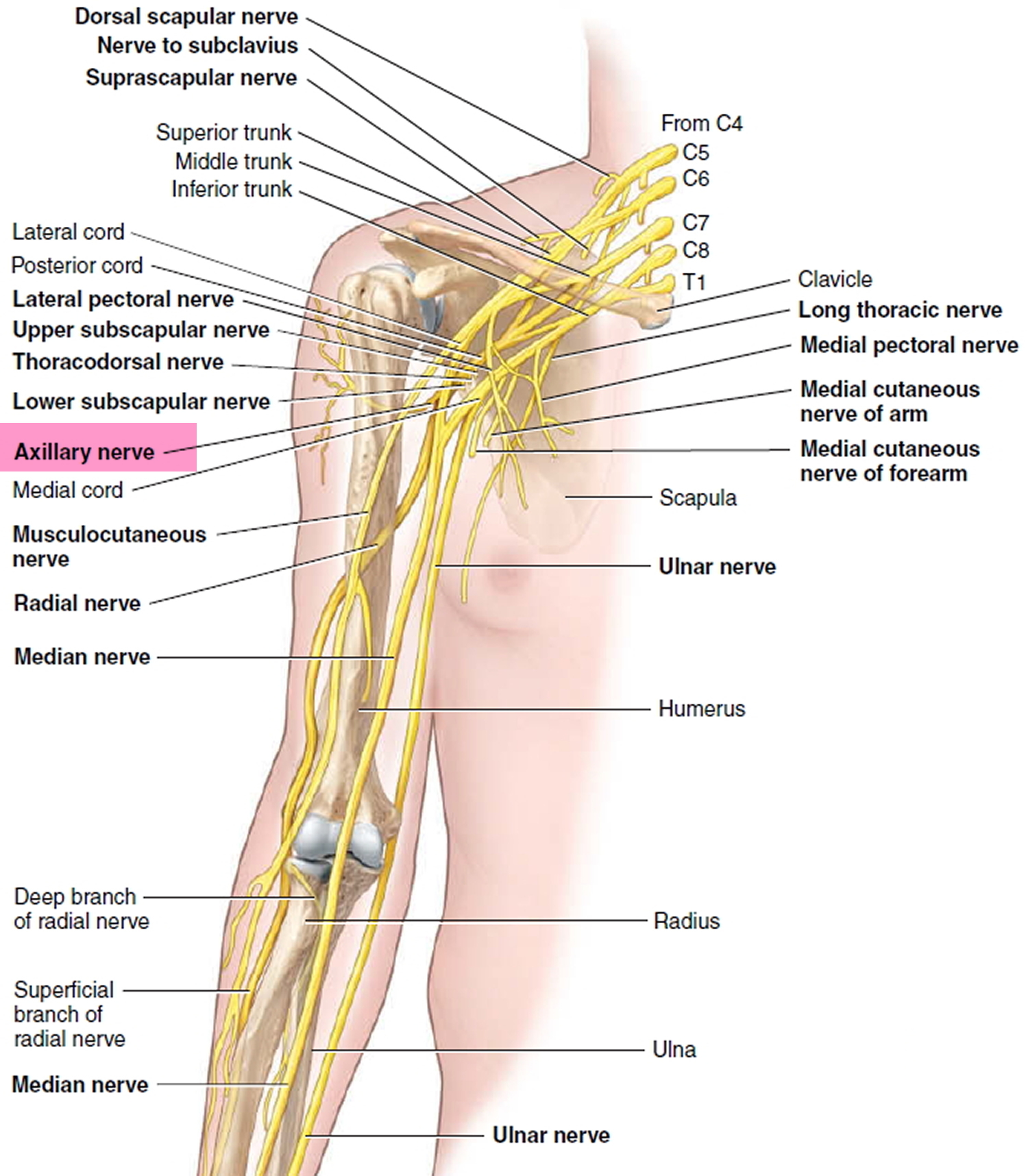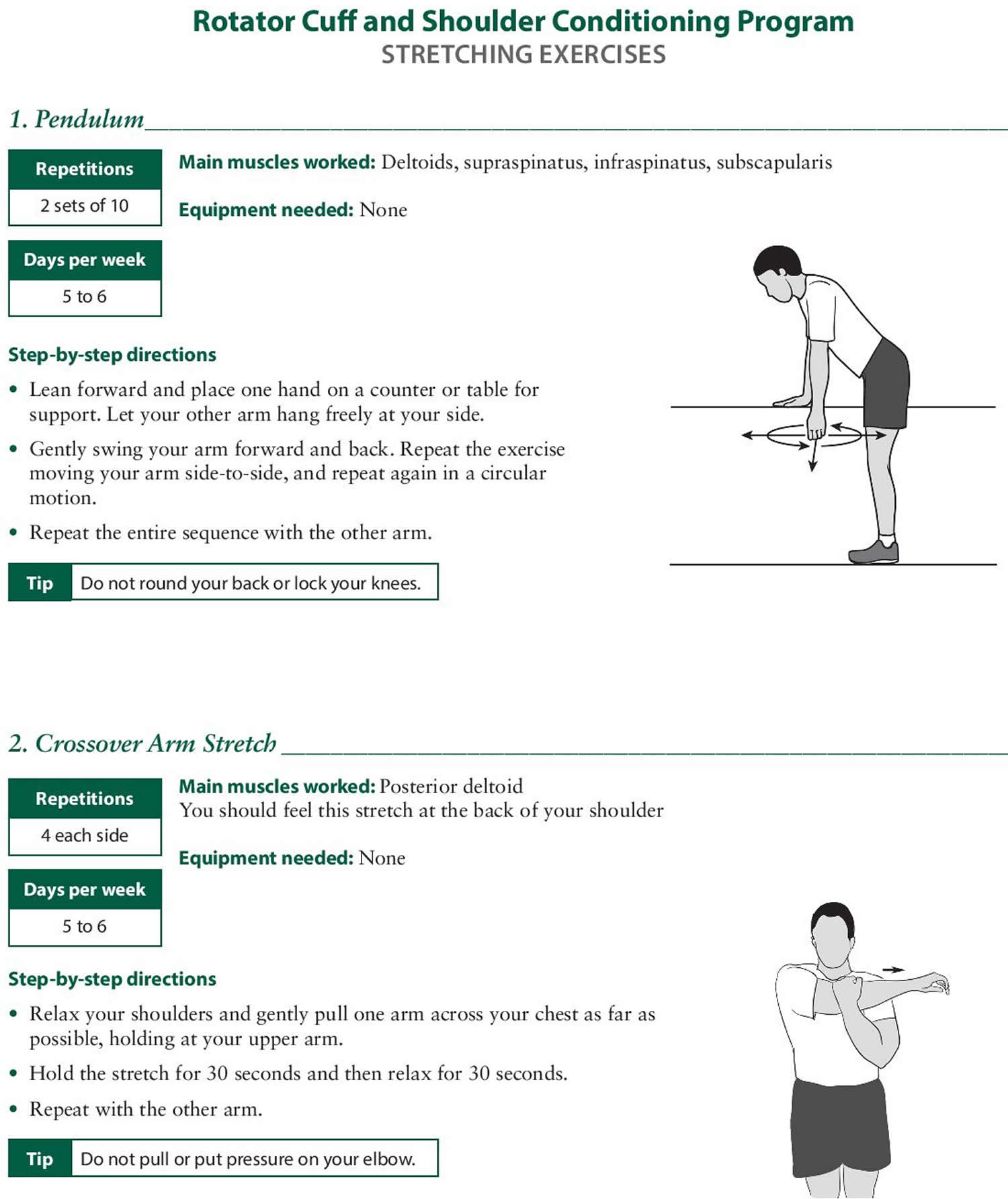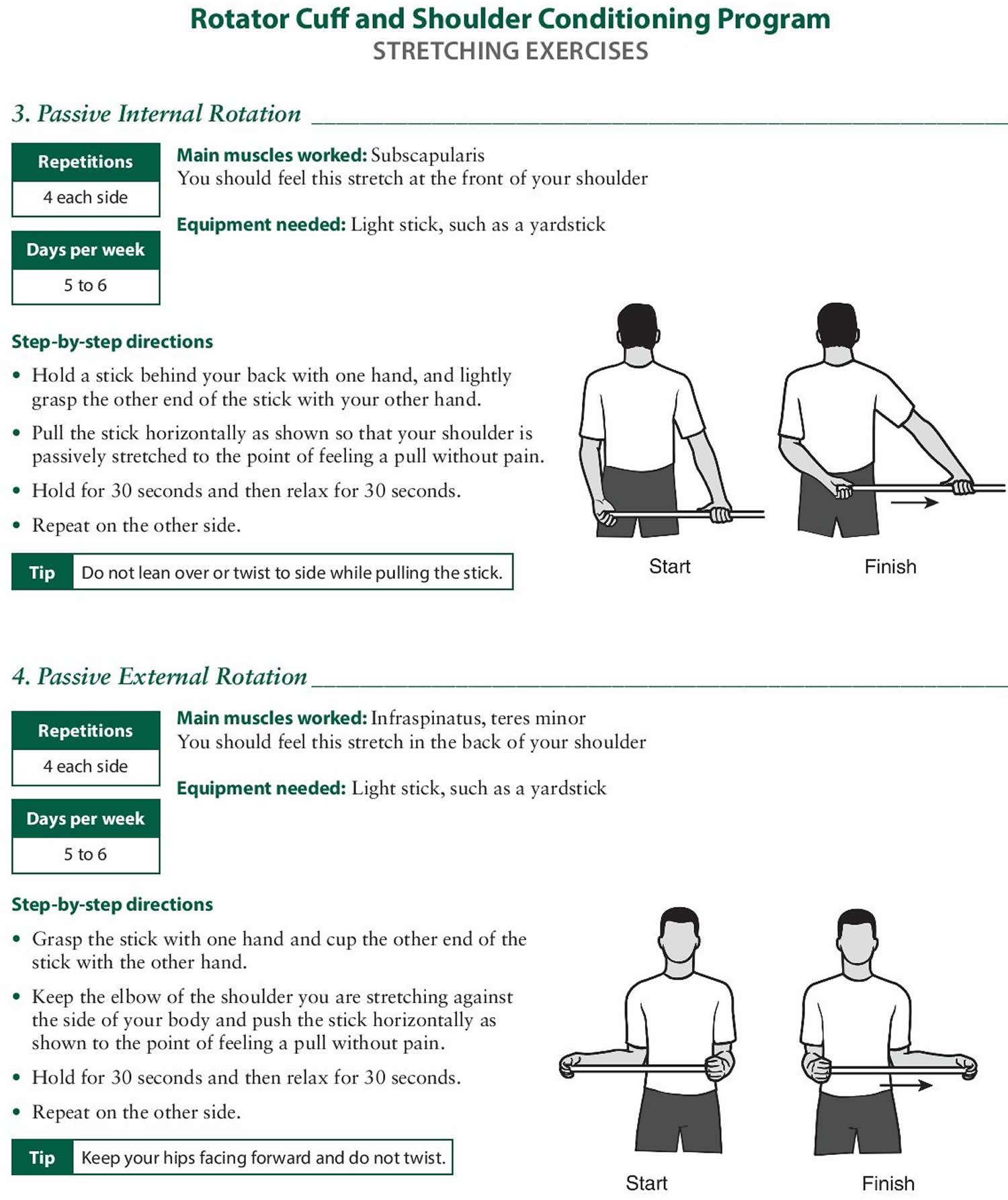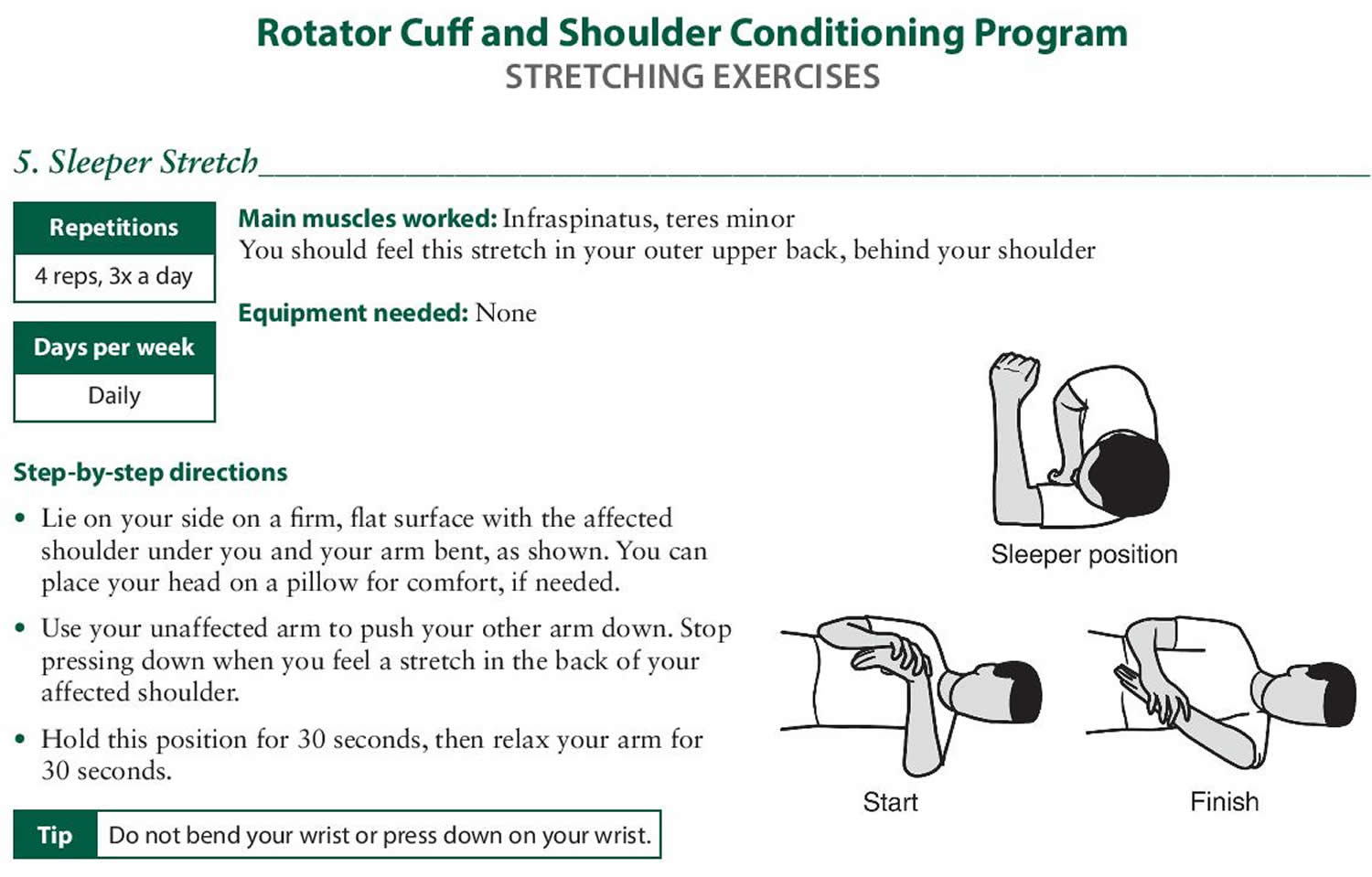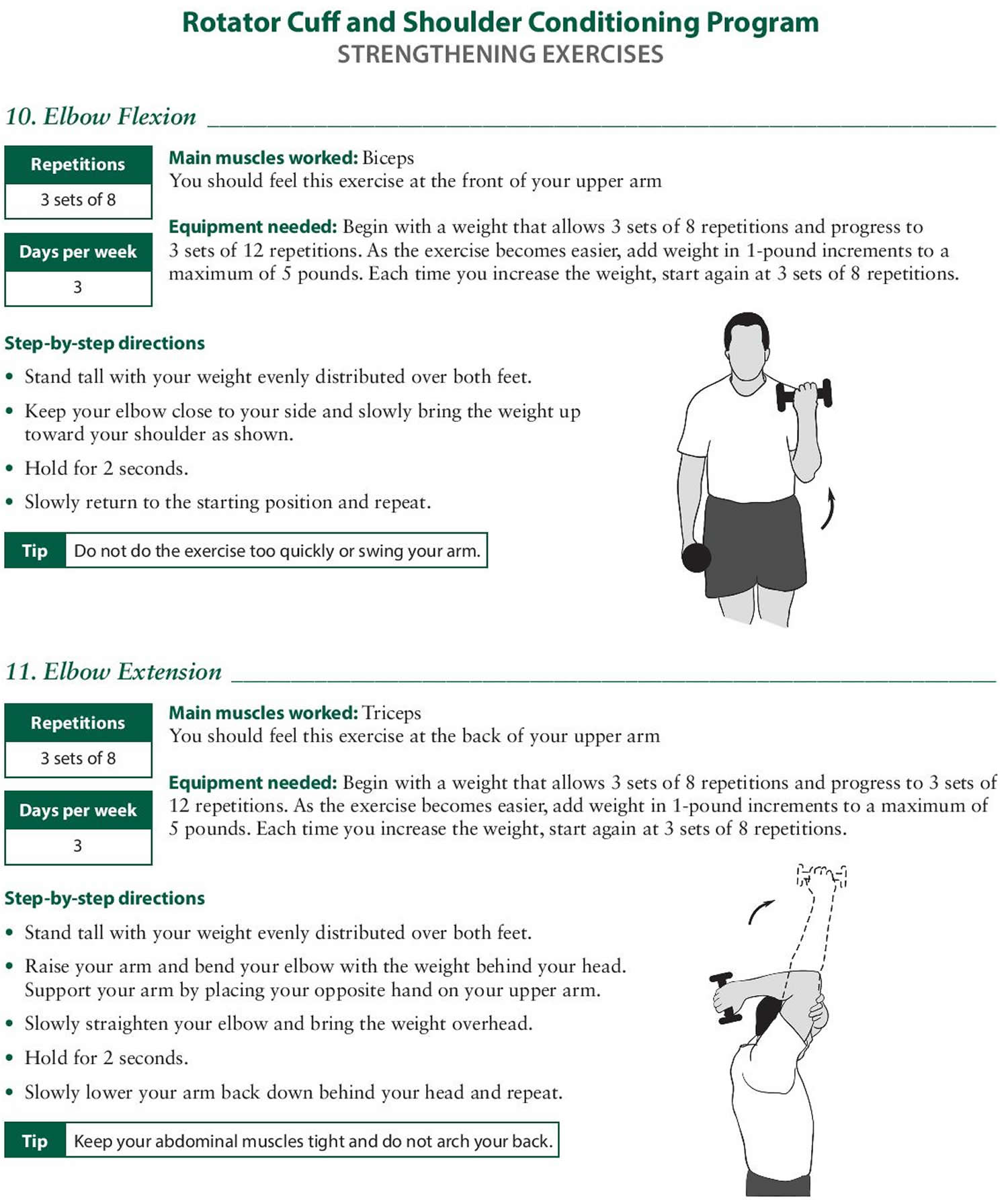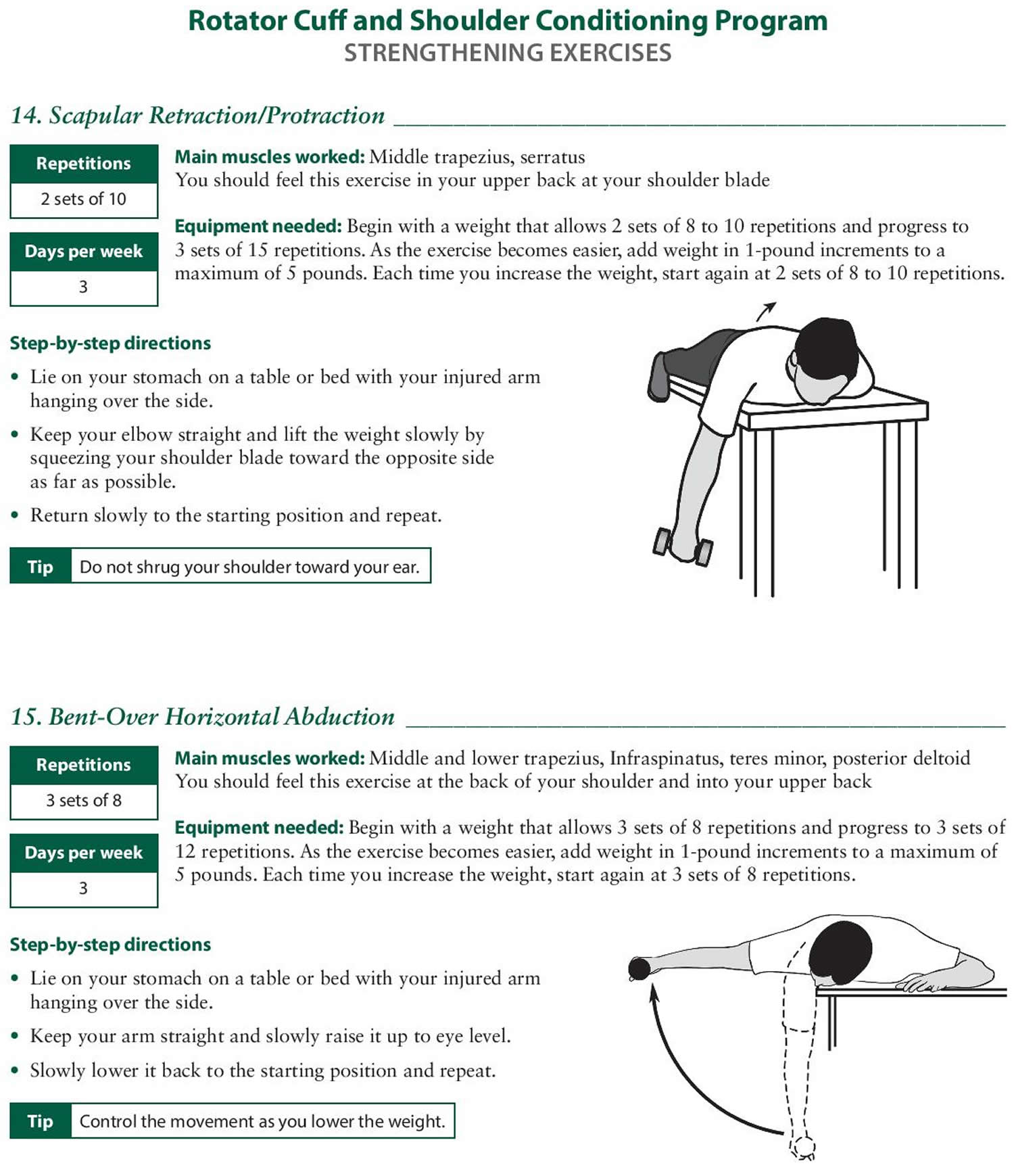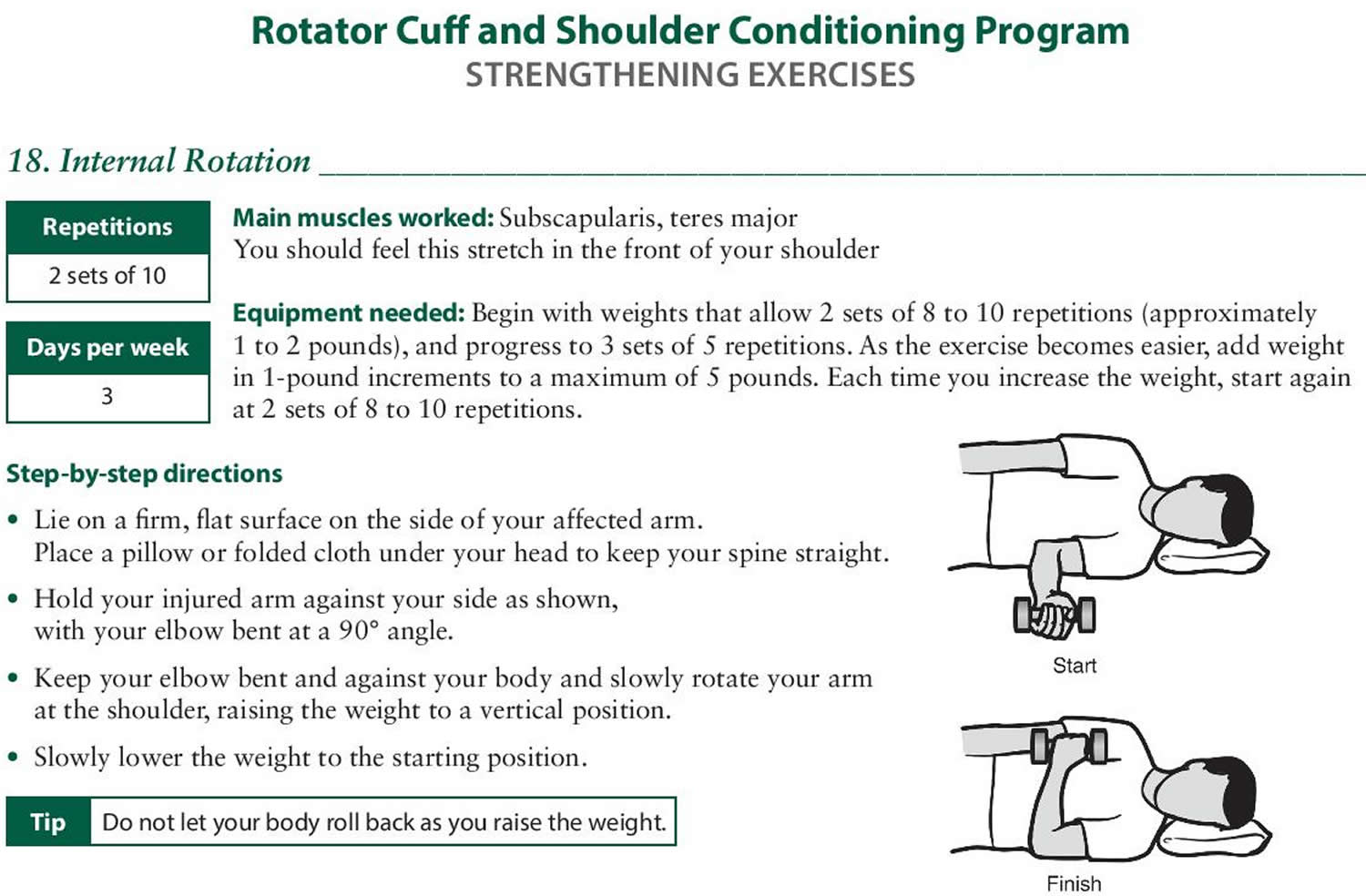Contents
- What is dislocated shoulder
- Shoulder anatomy and stability
- Anterior shoulder dislocation
- Posterior shoulder dislocation
- Inferior shoulder dislocation
- Multidirectional shoulder instability
- Shoulder dislocation causes
- Shoulder dislocation Risk Factors
- Dislocated shoulder signs and symptoms
- Dislocated shoulder diagnosis
- How to fix a dislocated shoulder
What is dislocated shoulder
The shoulder joint is a ball and socket joint and the shoulder is the body’s most mobile joint partly because the socket in which it lies is very shallow. This means it is the most likely joint in the body to dislocate. And because the socket is very shallow, it is mainly the ligaments and muscles that hold the shoulder in place, not the bone. The head of the humerus is held in its places by bone, ligaments and muscles (see Figures 1 to 4). This allows the shoulder to turn in many directions. But, this advantage also makes the shoulder an easy joint to dislocate.
Around 2% of the population have some instability of the shoulder joint. Overall, 1.7% of people dislocate their shoulder, though this statistic may almost double in people with high physical demands. Almost half of dislocations occur in people aged between 15 and 29.
Shoulder dislocations can cause more than just pain. Shoulder dislocation can also damage the surrounding joint structure, including the bone, ligaments and muscles.
The force of the bone popping out may cause small sections of cartilage or bone from the shoulder socket to tear away or break off (fracture). Some sort of damage to the bone, ligaments or muscles occurs in most shoulder dislocations, and bone fractures occur in about a quarter of dislocations.
There is more than one way to dislocate a shoulder, unfortunately.
How a dislocated shoulder occurs
You can dislocate your shoulder if you fall on to your arm heavily. Most people dislocate their shoulder while playing a contact sport, such as rugby, or in a sports-related accident.
In older people, the cause is often falling on to outstretched hands – for example, after slipping on ice.
Shoulder dislocations can occur more easily in people who are highly flexible, such as those with loose joints (joint hypermobility).
Anterior shoulder dislocation is when the joint pops out of the socket in a forward direction. It is the most common type of dislocation – about 95% of shoulder dislocations are of this type. They usually occur in a person for the first time when their arm is extended above their head and additional force causes the arm to extend further up than it should, allowing the ball to pop out of its shallow joint.
Posterior shoulder dislocations are those that involve the ball popping out of the socket in a backward direction.
Inferior dislocations are those in which the joint dislocates in a downward direction – they are more serious, but account for only 0.5% of all dislocations.
A partially dislocated shoulder (subluxation) means the head of the upper arm bone (head of humerus) is partially out of the socket (glenoid). A complete dislocated shoulder means the upper arm bone (head of humerus) is all the way out of the socket. Both partial and complete dislocations cause pain and unsteadiness in the shoulder.
People who are double jointed have a higher risk of dislocating their shoulder in any of the above directions.
Once the shoulder joint has dislocated, the head of the humerus becomes jammed against the outer structure of the socket. The pressure created when the joint sits outside the socket can cause a dent in the head of the humerus. This generally occurs in about half of shoulder dislocations in people under 40.
Shoulder dislocation may also damage the blood vessels or nerves that supply the arm.
These injuries cause the shoulder joint to become less stable, which means that after the first shoulder dislocation, you’re far more likely to experience a second shoulder dislocation and develop osteoarthritis in the shoulder joint.
Having surgery to repair the damaged joint can considerably reduce the risk of future dislocations. So if you can pop your shoulder out, you may want to consider talking to an orthopedic surgeon.
NEVER try to replace a dislocated shoulder yourself. You may cause further damage to the joint, and besides, DIY surgery is never a good idea.
Shoulder dislocation can be treated by replacing the shoulder joint into its socket. The doctor will x-ray the shoulder before replacement to assess the nature and extent of damage.
There are a number of ways to manipulate the joint back into place, which typically involve rotating and moving it. Don’t worry, painkillers are usually given. An x-ray may be taken afterwards to confirm correct relocation, and the arm is usually put in a sling.
Once the joint is replaced, muscles, nerve and ligament damage usually resolve. However, surgery to stabilize the joint has been shown to reduce the chance of a subsequent dislocation and may be necessary in cases where the shoulder joint has been damaged.
You may also need a little physiotherapy to help rehabilitate the shoulder joint.
How to tell if your shoulder is dislocated
In most cases of dislocated shoulder, the ball part of the shoulder joint pops out in front of the shoulder socket.
This is usually obvious because:
- you won’t be able to move your arm and it will be very painful
- your shoulder will suddenly look square rather than round
- you may be able to see a lump or bulge (the top of the arm bone) under the skin in front of your shoulder
It’s much more unusual for the bone to pop out of the back of the shoulder joint. This can usually happen after an epileptic fit or an electrocution injury, and is less easy to spot.
The muscles around the shoulder joint may have spasms from the dislocation, and this can make it hurt more. When the shoulder dislocates time and again, there is recurrent shoulder instability.
The doctor will examine the shoulder and may order an x-ray. It is important that the doctor know how the dislocation happened and whether the shoulder had ever been dislocated before.
What to do with a dislocated shoulder
Go to your nearest accident and emergency department immediately if you think you’ve dislocated your shoulder.
Don’t try to pop your arm back in yourself – you could damage the tissues, nerves and blood vessels around the shoulder joint.
While waiting for medical help, avoid moving your upper arm as much as possible.
Place something soft, such as a folded blanket or pillow, in the gap between your arm and the side of your chest to support it.
If you can, make a simple sling to hold your lower arm across your chest, with the elbow bent at a right angle.
See your doctor or go to the emergency room right away if you have:
- Severe pain
- Weakness in your arm or fingers
- Numb or cold fingers
- A sharp decrease in how well you can move your arm
- A lump on top of your shoulder that makes your shoulder look abnormal
Dislocated shoulder recovery time
A dislocated shoulder takes between 12 and 16 weeks to heal after the shoulder has been put back into place. You will be treated with ice, medicines, a sling, and then exercises as you continue to heal.
You’ll usually be able to resume most activities within two weeks, but should avoid heavy lifting and sports involving shoulder movements for between six weeks and three months. Your care team will advise you.
You’ll probably be off work for two to four weeks, or longer, if you have a physical job. Discuss this with your care team.
If you’ve also broken your arm or shoulder joint, you may need to wear your sling for up to six weeks and recovery will take longer.
Your recovery may be slower if you have:
- Arthritis in your shoulder joint
- Damaged cartilage (cushioning tissue) between your collarbone and top of your shoulder blade
- A severe shoulder dislocation
You may need surgery right away if you have:
- Numbness in your fingers
- Cold fingers
- Muscle weakness in your arm
- Severe deformity of the joint
Dislocated shoulder prognosis
The average age of individuals who dislocate their shoulder for the first time occurs in two peaks. The first group tends to be young adult men, with injury occurring due to high-impact mechanisms. The smaller second group are older individuals with lower-impact mechanisms of injury and lower rates of re-dislocation.
Dislocation may result in further instability of the shoulder joint, which may present as subtle joint looseness, or recurrent dislocation. Up to a third of people who experience shoulder dislocation go on to develop long-term shoulder osteoarthritis.
Dislocated shoulder complications
Complications of a dislocated shoulder may include:
- Tearing of the muscles, ligaments and tendons that reinforce your shoulder joint
- Nerve or blood vessel damage in or around your shoulder joint
- Shoulder instability, especially if you have a severe dislocation or repeated dislocations, which makes you more prone to re-injury.
If you stretch or tear ligaments or tendons in your shoulder or damage nerves or blood vessels around your shoulder joint, you may need surgery to repair these tissues.
The consequences of traumatic anterior shoulder dislocation depend on the severity of injury and the age of the person when they first dislocate their shoulder. The younger the person at first dislocation, the more likely they are to dislocate again. In athletic people aged younger than 20 years, rates of recurrent dislocation are as high as 90%, decreasing to 50–75% in people aged 20–25 years. In people older than 40 years, anterior shoulder dislocation is associated with lower rates of instability, but higher rates of rotator cuff muscle tears (15%). The risk of rotator cuff tears increases to 40% in people older than 60 years. The recurrence rate of dislocation is also related to the degree of injury of structures that support the shoulder joint at the time of dislocation.
Dislocating your shoulder again
The chances of dislocating your shoulder again will depend on your age and how well the tissues surrounding the joint healed the first time.
It can help if the torn tissues were surgically repaired after the dislocated shoulder was put back in place.
However, subsequent dislocations do sometimes occur, particularly in people younger than 25 and those over 40.
Doing regular recovery exercises under the supervision of a physiotherapist and avoiding awkward arm positions can also reduce the risk of dislocating your shoulder again.
Shoulder Dislocation and Instability Prevention
To help prevent a dislocated shoulder:
- Take care to avoid falls
- Wear protective gear when you play contact sports
- Exercise regularly to maintain strength and flexibility in your joints and muscles
Nothing has been proven to reduce the chances of dislocating a shoulder for the first time. Once a shoulder has been dislocated, surgery to stabilize the joint has been shown to reduce the chances of it dislocating again. Physiotherapy assists in rehabilitating the shoulder after a dislocation, though it will not reduce the risk of it recurring.
Shoulder anatomy and stability
The shoulder joint (also known as the glenohumeral joint) is the most mobile joint in the body, owing mainly to its unique anatomical structure which includes a very shallow socket. Unfortunately, it is also the most frequently dislocated joint in the human body. The joint is kept in place or stable by a combination of bone, ligaments and muscles, which all have an important part to play in shoulder stability. The bony part of the joint socket is very shallow, so it is important that all these structures are working well to prevent the joint from dislocating.
Figure 1. Shoulder girdle (pectoral girdle)
Figure 2. Shoulder joint
Figure 3. Shoulder joint (frontal view)
Figure 4. Shoulder joint (lateral view)
Figure 7. Dislocated shoulder
Anterior shoulder dislocation
Shoulder dislocation occurs in the anterior direction in 95% of cases. This means that the ball (head of the humerus or, in other words, the top part of the long bone in the upper arm) ‘pops out‘ in the forward direction. The first episode of an anterior dislocation usually occurs when a person has his/her arm positioned above his/her head, and an unexpected small further injury forces the arm that little bit further, pushing the shoulder into an extreme position which overcomes the structures that stabilise the shoulder joint, causing the ball to pop out of its socket.
Bankhart and Hill–Sachs lesions
The force of the head of the humerus (ball) popping out of the socket usually causes part of the gristle of cartilage (labrum) running around the rim of the socket to be torn off (see Figures 4 and 8). This is called a Bankhart lesion or labral tear. Sometimes a small piece of bone can be torn off with the labrum.
When the ball has popped out of position, the back of the ball is jammed up against the socket. This causes a dent in the ball known as a Hill–Sachs lesion. In people under 40 years with anterior shoulder dislocation, around half experience Hill–Sachs lesions.
Figure 8. Anterior shoulder dislocation
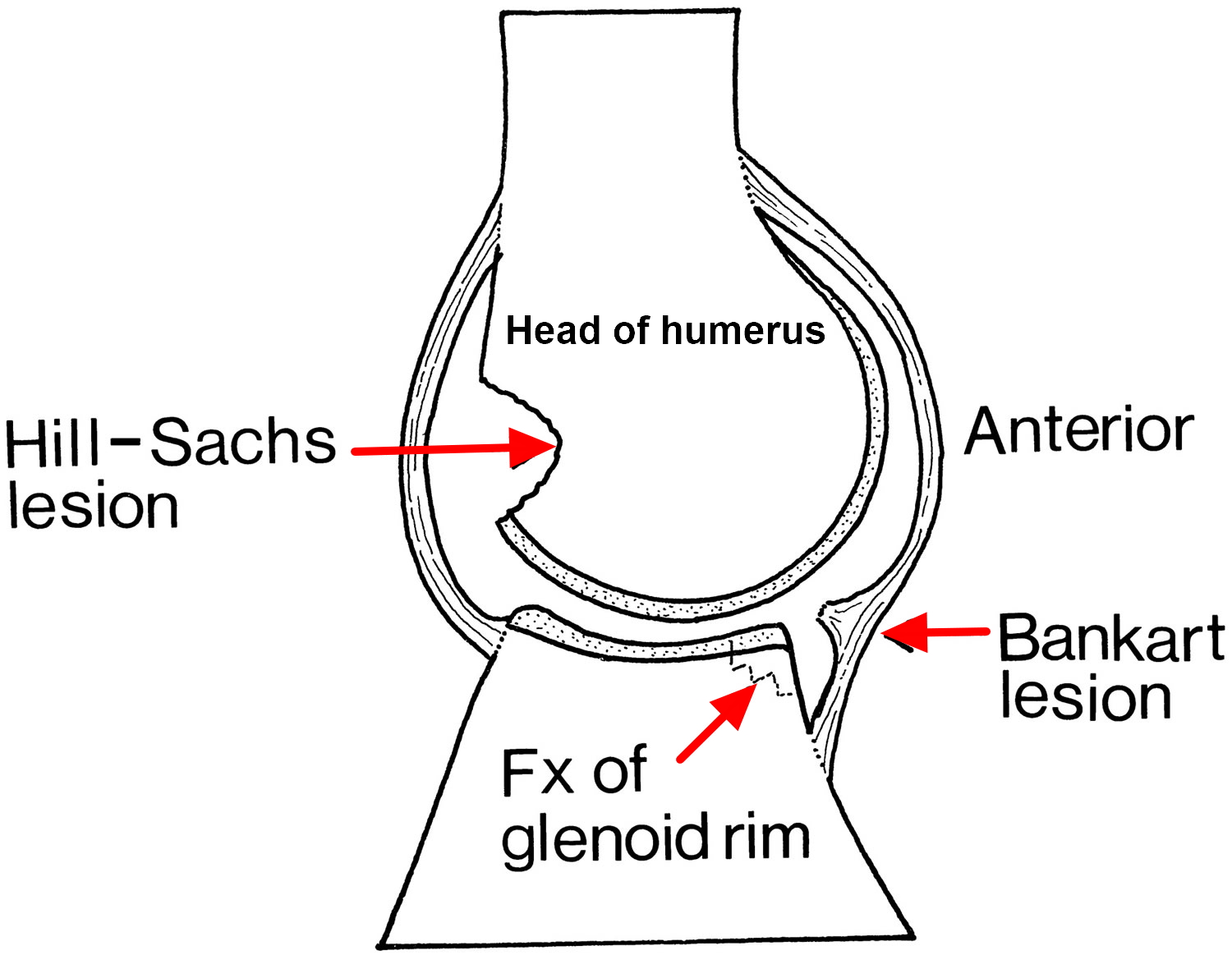
Risk of further shoulder dislocations
After somebody has had a shoulder dislocation, the damage to their shoulder means that they have a higher chance of further shoulder dislocations. The chance of further instability can be estimated at approximately 60%, but does depend on age and activity level. Physiotherapy does help the shoulder recover from an initial shoulder dislocation, but does not reduce the chance of further shoulder dislocations. A 60% risk of further instability is not acceptable to some of the population, who choose surgery early to lower their chance of further instability to 5%.
There are some significant disadvantages to sustaining repeat shoulder dislocations – for example, 15% of drownings are thought to be associated with a dislocated shoulder. There is a greater risk of osteoarthritis (wear and tear and loss of cartilage in the joint) with increasing numbers of dislocations. In addition, each dislocation usually results in more bone loss from the humeral head and glenoid, which lowers the chance of success of minimally invasive (arthroscopic) surgery, and may mean that an open bone grafting procedure (Laterjet procedure) will be required.
Injury to nerves and blood vessels
Damage to the axillary artery (which runs through the armpit and supplies the arm) occurs in 1–2% of shoulder dislocations, more commonly in the older age group as their blood vessels are less elastic.
Nerve injuries are more common, particularly of the axillary nerve, which occurs in around 10–40% of shoulder dislocations. The axillary nerve wraps around the neck of the humerus, and supplies the deltoid muscle, one of the most important muscles around the shoulder joint, and the skin overlying the side of the shoulder (where a shoulder badge would be worn on the sleeve of a jacket). Most people with axillary nerve damage recover without treatment, as the symptoms go away when the shoulder is put back in position. Less commonly there may be damage to the brachial plexus, which is a network of nerves that run from the neck and supply the arm. This is more likely when dislocation occurs with the arm out to the side, with the elbow bent at 90 degrees and the hand hanging down. Again, the recovery from damage to the brachial plexus associated with shoulder dislocation is usually good.
Figure 9. Nerves passing near the shoulder joint
Figure 10. Axillary artery coursing through the shoulder joint

Fractures (broken bones) and rotator cuff tears
Significant fractures occur in around one quarter of shoulder dislocations, and are more common when there is a traumatic mechanism of injury, first-time shoulder dislocation, or the person is aged over forty. If there is a fracture and a piece of bone has moved from where it should be (displaced), then it usually needs surgery.
Rotator cuff muscle tears are reported to occur in 14–63% of anterior dislocations, more commonly in older people. Any older person who has had a shoulder dislocation 2 weeks ago and now cannot lift their arm above shoulder level most likely has a massive rotator cuff tear, and should have surgery as soon as possible.
Posterior shoulder dislocation
Posterior shoulder dislocation means the head of the humerus ‘pops out’ in a backwards direction, which is the case in 2–4% of shoulder dislocations. This tends to occur when there is a blow to the front of the shoulder, violent muscle contractions due to a seizure (fit) or electrocution, or the arm is bent across the body and pushed backwards. Injuries that are commonly associated with posterior dislocation include fractures, rotator cuff tears, and Hill–Sachs lesions.
Inferior shoulder dislocation
Inferior shoulder dislocation means the head of the humerus sits below the socket once it has ‘popped out’. Only 0.5% of shoulder dislocations occur inferiorly. It is caused by forceful moving of the arm over the head toward the other side of the body, or by pulling on the arm when it is fully extended over the head as may occur when grasping an object above the head to break a fall. Injuries associated with inferior dislocation include damage to nerves (60%), rotator cuff tears (80%), and injury to blood vessels (3%).
Multidirectional shoulder instability
Multidirectional instability of the shoulder is a condition that sometimes occurs in people who are “double-jointed“, which is also known as having ligamentous laxity. Multidirectional instability of the shoulder occurs in younger patients, and can cause both pain and symptoms of instability. The direction of instability can be anterior, posterior and/or inferior, hence the name.
Patients with multidirectional instability of the shoulder usually do not have any tear or definable anatomical problem in the shoulder. They are best treated with an extensive physiotherapy program lasting at least 6 months, which involves developing a conscious understanding of the position of the ball in the socket and how to keep it there by contracting the correct muscles through the various range of motions of the shoulder.
Shoulder dislocation causes
The shoulder joint is the most frequently dislocated joint of the body. Because it moves in several directions, your shoulder can dislocate forward, backward or downward, completely or partially, though most dislocations occur through the front of the shoulder. In addition, fibrous tissue that joins the bones of your shoulder can be stretched or torn, often complicating the dislocation.
It takes a strong force, such as a sudden blow to your shoulder, to pull the bones out of place. Extreme rotation of your shoulder joint can pop the ball of your upper arm bone out of your shoulder socket. Partial dislocation — in which your upper arm bone is partially in and partially out of your shoulder socket — also may occur.
A dislocated shoulder may be caused by:
- Sports injuries. Shoulder dislocation is a common injury in contact sports, such as football and hockey, and in sports that may involve falls, such as downhill skiing, gymnastics and volleyball.
- Trauma not related to sports. A hard blow to your shoulder during a motor vehicle accident is a common source of dislocation.
- Falls. You may dislocate your shoulder during a fall, such as from a ladder or from tripping on a loose rug.
Shoulder dislocation Risk Factors
Males in their teens or 20s, a group that tends to be physically active, are at highest risk of shoulder dislocation.
Risk factors for shoulder dislocation include:
- Gender: Around 70% of shoulder dislocations occur in males;
- Age: Almost half of dislocations occur between the ages of 15 and 29;
- Mechanism: 95% of anterior shoulder dislocations are due to traumatic injury, most commonly resulting from a fall (60%). Almost half of dislocations occur during sports or recreation. Those who play certain sports, or who undertake activities with high physical demands (such as individuals in the armed forces) are at increased risk;
- Location: 47.7% of dislocations occur at home, while 34.5% occur at sites of sports or recreation;
- Anatomy and function: It is likely that factors such as shallow joint sockets, weak shoulder muscles, and loose ligaments increase the risk of shoulder dislocation, although these factors have not been proven in studies; and
- Previous shoulder dislocation: The strongest risk factor for shoulder dislocation is previous dislocation.
Dislocated shoulder signs and symptoms
Shoulder dislocation is associated with symptoms of pain, deformity and an inability to move the shoulder joint. Sometimes a dislocation may tear ligaments or tendons in the shoulder or damage nerves. There may be numbness, tingling, or coldness of the arm if nerves or blood vessels are involved. The person may also be aware of the feeling of the humerus ‘popping out’ of the socket as the injury occurs.
Dislocated shoulder symptoms to look for include:
- Deformity
- Swelling
- Numbness
- Weakness
- Bruising
The shoulder joint can dislocate forward, backward, or downward. A common type of shoulder dislocation is when the shoulder slips forward (anterior instability). This means the upper arm bone (head of humerus) moved forward and out of its socket. It may happen when the arm is put in a throwing position.
It is important for the doctor to be able to establish the cause of instability if one is apparent. This may involve a traumatic dislocation event, repetitive micro-trauma (for example due to overhead activity), or inherited hyper-mobile joints. Pain or instability may be associated with specific positions. Symptoms of instability or dislocation at night may suggest severe instability.
Following shoulder dislocation, there may be some remaining instability of the shoulder once it is back in place. Anterior (forward) instability following shoulder dislocation usually is evident due to pain, fear or discomfort when the arm is in a ‘stop sign’ position. Posterior (backward) instability results in symptoms when the arm is crossing the body and turned inward. Inferior (downward) instability may present as pain or tingling while carrying heavy objects or with pulling downwards on the arm. In some instances, instability is multidirectional (in several directions).
Dislocated shoulder diagnosis
People with anterior (forward) shoulder dislocation tend to hold their arm by their side, supported by their other arm. They tend to resist attempts at movement. On inspection, there may be some deformity at the shoulder joint, due to the head of the humerus sitting in the wrong place.
When the shoulder is dislocated posteriorly (backwards), there is a flattening of the shoulder at the front, and a fullness at the back of the shoulder where the dislocated humeral head is sitting. The arm is held across the body and turned in, and cannot be turned out. With inferior (downward) shoulder dislocation, the arm is unable to be moved out to the side, and tends to be held above the person’s head with the forearm resting on the head.
The doctor will assess for damage to bone, nerves and blood vessels before they put the shoulder joint back in place (known as ‘reducing‘ the shoulder).
You’ll be assessed and examined when you get to the hospital emergency room. You’ll usually have an X-ray to check whether you’ve broken any bones and confirm the dislocation.
If you have a fracture, you may have further scans to investigate the area in more detail. Fractures with a shoulder dislocation require specialist orthopaedic care, and you may need surgery.
If you don’t have any fractures, your arm will be gently manipulated back into its shoulder joint using a procedure known as reduction.
In the more chronic setting, several tests may be performed to assess for shoulder instability. Pain and instability in certain positions may indicate the direction and degree of instability. The apprehension test involves moving the shoulder into a ‘stop sign’ position. If the patient shows fear (apprehension), discomfort or guarding, the test is considered positive and indicates anterior instability is present.
Investigations and tests
Following shoulder dislocation, the doctor will arrange a shoulder x-ray, usually before they attempt to put the joint back in place (reduce it). This is to confirm the dislocation, and to look for any fractures which would make reducing the joint unsafe. Once the joint has been put back, another x-ray will be done to confirm the joint is in the correct position. When there are more complicated injuries, CT or MRI scans may be necessary to check for injury to muscles, cartilage, other ‘soft tissues’ and subtle bone damage.
How to fix a dislocated shoulder
Dislocated shoulders should be put back in place (reduced) as soon as x-rays have been taken. It is essential that this procedure is carried out by trained medical staff, as there is a risk of damage to blood vessels, nerves and the possibility of fracture if it is not done properly.
Pain relief options
Options for pain relief while shoulders are put back in place include:
- No sedation: Anesthesia may not be required for people who have dislocated their shoulder before, and have done it again with minimal trauma. This works best with techniques that do not require significant force, such as external rotation, scapular manipulation, or Milch technique (see below);
- Nitrous oxide (laughing gas);
- Sedation with injection of anesthetic into the veins may be required to reduce muscle spasm and relieve pain. The patient is briefly asleep while the shoulder is put back in place. Common options include the drugs known as midazolam, fentanyl, propofol and ketamine. Procedural sedation requires appropriate monitoring and supervision, and the ability to provide airway support if it is required.
How to treat a dislocated shoulder
- Again, it must be emphasized that putting a dislocated shoulder back in place must not be attempted by untrained individuals.
There is no one technique that is better than the others for reducing a dislocated shoulder. The choice is usually made based on the condition of the individual and the preference of the clinician. The individual will be informed of the risks of reduction, which include risks of anesthetic, fractures, rotator cuff injuries (usually present before reduction), and damage to arteries and nerves, which are rare when good technique is used.
Certain people may be referred to orthopedic surgeons (specialist bone doctors) before an attempt is made to put the joint back in place. People who may be considered for this course of action include elderly patients (due to their increased risk of fracture or nerve and blood vessel injury during relocation attempts), and anyone younger than 10 years of age (due to risk of fractures that may affect the growth of the bone).
Options for reduction of anterior shoulder dislocation include:
- Traction/counter-traction: This is the least traumatic and most advisable method to use. A sheet or towel is wrapped under the armpit to apply counter-traction from the opposite side of the patient to the clinician who is providing gentle continuous traction at the wrist or elbow, in a direction that is slightly abducted (30 degrees) and forwardly flexed (30 degrees);.
- Scapular manipulation: With the individual lying on their stomach, or sitting upright, the shoulder blade is rotated by pushing the tip toward the spine and the socket downwards, while an assistant provides gentle forward or downward traction on the arm. This disengages the humeral head from the socket, and allows it to reduce into anatomical position. This technique is quick (1–5 mins) and well tolerated, and is successful in over 80% of attempts;
- External rotation: This manoeuvre takes 5–10 minutes. The individual is lying on their back, with the elbow bent to 90 degrees. The clinician holds the individual’s elbow and wrist, and very slowly the individual allows their arm to rotate outwards as the clinician guides the movement. Whenever pain or spasm is felt, the movement is stopped and the muscles are allowed to relax. The “clunk” associated with reduction using other techniques may not be evident. Reduction usually occurs once the arm is externally rotated between 70 and 110 degrees;
- Milch technique: If reduction using external rotation is unsuccessful, the Milch technique can be added. The fully outwardly rotated arm is taken out to the side into an overhead position, maintaining external rotation throughout. Gentle traction is applied in line with the arm bone, and there is direct pressure placed over the humeral head via the clinician’s thumb in the armpit. This technique is successful in over 86% of cases.
- Spaso technique: Gentle vertical traction and outward rotation is applied to the dislocated arm while the individual is lying on their back.
Other techniques have been described, but are considered complex, or associated with complications. Reduction is achieved when there is a “clunk” as the humeral head returns to the socket, and the individual is able to place the affected hand on the opposite shoulder. Reduction will be confirmed with an x-ray.
Dislocated shoulder rehabilitation
The period of immobilization following reduction is variable, though immobilization in a standard sling has not been shown to effect the chance of recurrence. Immobilization is usually achieved using a sling to maintain a position of internal rotation. However, recent reports have concluded that immobilization in a position of external rotation of the humerus may result in lower rates of recurrent dislocation. The problem with this technique is the significant inconvenience the individual experiences by having their arm positioned in an externally rotated position for 24 hours per day. This concept requires further studying before it is adopted for routine use.
Your doctor may immobilize the shoulder in a sling or other device for several weeks following treatment. Plenty of early rest is needed. The sore area can be iced 3 to 4 times a day.
The period of immobilization is followed by rehabilitation with physiotherapy targeted towards restoring the range of motion and improving the strength of the shoulder joint to maximize its stability.
After the pain and swelling go down, the doctor will prescribe rehabilitation exercises for you. These help restore the shoulder’s range of motion and strengthen the muscles. Rehabilitation may also help prevent dislocation of the shoulder again in the future. Rehabilitation will begin with gentle muscle toning exercises. Later, weight training can be added.
If shoulder dislocation becomes a recurrent problem, a brace can sometimes help. However, if therapy and bracing fail, surgery may be needed to repair or tighten the torn or stretched ligaments that help hold the joint in place, particularly in young athletes.
At times, the recurrently dislocating shoulder can result in some bone damage to the humerus or shoulder socket. If your surgeon identifies some bone damage, he or she may recommend a bone transfer type of surgery.
Follow-up
If you continue to have pain, your provider will probably ask you to come back in 1 week to decide if you need to:
- See an orthopedist (bone doctor)
- Begin physical therapy or range of motion exercises
Dislocated shoulder Self-care at Home
Make an ice pack by putting ice in a sealable plastic bag and wrapping a cloth around it. DO NOT put the bag of ice directly on the area, as the ice could damage your skin.
On the first day of your injury, apply the ice every 10 to 15 minutes, for 20 minutes each time. After the first day, ice the area every 3 to 4 hours for 20 minutes each time. Do this for 2 days or longer, or as instructed by your provider. After two or three days, when the pain and inflammation have improved, hot packs or a heating pad may help relax tight and sore muscles. Limit heat applications to 20 minutes at a time.
For pain, you can take ibuprofen (Advil, Motrin), naproxen (Aleve, Naprosyn), aspirin, or acetaminophen (Tylenol). You can buy these pain medicines without a prescription.
- Talk with your provider before using these medicines if you have heart disease, high blood pressure, kidney disease, or have had stomach ulcers or bleeding.
- DO NOT take more than the amount recommended on the bottle.
- DO NOT give aspirin to children.
You may be given a shoulder sling to use for a few weeks.
- Once you have less pain, begin range of motion exercises so that your shoulder does not get stuck in place. This is called contracture. Check with your provider before doing any of these motions.
- After your injury has healed, DO NOT lift heavy objects for 8 to 12 weeks.
- Rest your shoulder. Don’t repeat the specific action that caused your shoulder to dislocate, and try to avoid painful movements. Limit heavy lifting or overhead activity until your shoulder feels better.
Arm and shoulder exercises
Some gentle arm and shoulder exercises may be recommended for you to do at home with your arm out of its sling.
These will help:
- reduce stiffness
- relieve some of the pain
- build up strength in your shoulder muscles
It’s likely you’ll feel some aching, discomfort or stretching when doing these exercises. However, if you experience intense pain for more than 30 minutes, do the exercise less forcefully and less often.
Once your injury heals and you have good range of motion in your shoulder, continue exercising. Daily shoulder stretches and a shoulder-strengthening and stability program can help prevent a recurrence of dislocation. Your doctor or a physical therapist can help you plan an appropriate exercise routine.
Shoulder exercises
Dislocated shoulder surgical management
Some people tear ligaments, tendons and other tissues when they dislocate their shoulder.
If these tissues have been damaged, you may need surgery to repair them. This can significantly reduce the risk of dislocating the same shoulder again in the future for some people.
This is particularly the case for people whose joint is still unstable following conservative management as outlined above, and who have damage to the joint (such as a Hills–Sachs or Bankhart lesion). Surgery is associated with a 95% reduction in re-dislocation. The procedure may be performed as an open or a keyhole procedure, and there is no significant difference in terms of shoulder stability, re-injury, requirement for further surgery, or shoulder function between the two methods.
Surgery to repair shoulder tissues is carried out under general anesthetic. It’s often done using keyhole surgery, where small cuts (incisions) and a thin tube with a light and camera at one end (arthroscope) are used.
Sometimes it’s necessary to have open surgery to move bones around in the shoulder to prevent further dislocations.
Surgery can sometimes be avoided by doing appropriate exercises to strengthen the shoulder if the tissues are overstretched but not torn.
